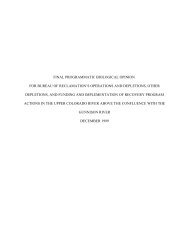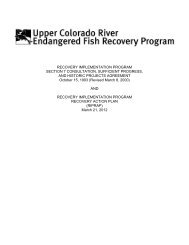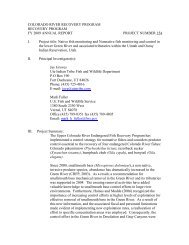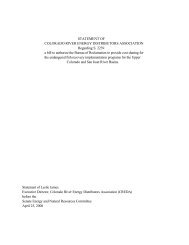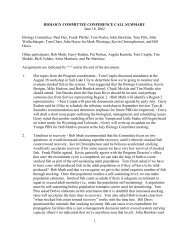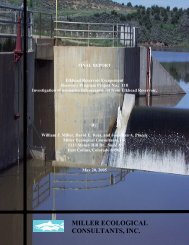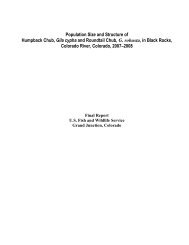K. R. Bestgen, K. A. Zelasko, and G. C. White. Monitoring ...
K. R. Bestgen, K. A. Zelasko, and G. C. White. Monitoring ...
K. R. Bestgen, K. A. Zelasko, and G. C. White. Monitoring ...
You also want an ePaper? Increase the reach of your titles
YUMPU automatically turns print PDFs into web optimized ePapers that Google loves.
lack of convergence. Simulation run results were censored (not a full 1,000 simulations was<br />
achieved because some failed to converge or abundance was estimated at greater than 10X the<br />
simulated level) at some reasonable level of abundance relative to the simulation parameters <strong>and</strong><br />
often reduced bias relative to what is reported, but the main point here is that estimating<br />
abundance when population size is small <strong>and</strong> p’s are low is not advisable because highly biased<br />
estimates can result, sometimes negative but often positive. Increasing number of sampling<br />
passes when population size is 1,000 when p = 0.05 is advisable because 3 sampling passes<br />
resulted in potential average positive bias of nearly 20%. Relatively low average bias resulted<br />
when p’s were 0.10 or greater under all population sizes with 3 or 4 sampling passes, or when p<br />
= 0.05 or higher with population size of 2,500 or 5,000, especially when sampling pass number<br />
was increased from 3 to 4. In general, increasing the number of sampling passes from 3 to 4<br />
reduced bias by 50% or more, regardless of the level of p or population size.<br />
Similar to reducing bias, increased precision of abundance estimates was obtained by<br />
increasing probabilities of capture, increasing sampling passes from 3 to 4, <strong>and</strong> increasing<br />
population size under consideration (Figure 13). The CV’s were high under all scenarios when p<br />
= 0.02, <strong>and</strong> remained high when p = 0.05 <strong>and</strong> population size was 1,000 or 2,500. When<br />
sampling yields p’s per pass of 0.10, estimates of abundance are relatively precise for all<br />
population sizes ranging from 1,000 to 5,000, especially when 4 sampling passes were<br />
employed. In general, addition of a fourth sampling pass was less effective than expected for<br />
increasing precision, when compared to addition of a fourth pass for bias reduction.<br />
The CV’s generated from simulation results are generally consistent with CV’s for<br />
abundance estimates generated by field sampling. For example, CV’s of abundance estimates<br />
(1,600 to 5,200) for razorback suckers in the lower Green River from 2006–2008 were 22 to 37%<br />
with p’s of 0.01 to 0.07 using 3-pass sampling. Those are similar to CV’s for a simulated<br />
population of 2,500 animals with p = 0.05 <strong>and</strong> three sampling passes, which averaged 29.6%.<br />
Similarly, middle Green River abundance estimates for Colorado pikeminnow from 2000–2003<br />
that ranged from 660 to 1,600 had CV’s of 9 to 18% with p’s of 0.04 to 0.13 using 3-pass<br />
sampling. Those CV’s are similar to those for simulated populations where 3 sampling passes<br />
were conducted with p = 0.10 <strong>and</strong> population size was 1,000 or 2,500 animals, <strong>and</strong> resulting<br />
CV’s were 9 <strong>and</strong> 19% respectively.<br />
44



